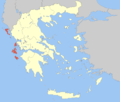Paxi
Paxi or Paxoi and Antipaxoi or Antipaxos (Greek: Παξοί και Αντίπαξοι, pronounced /pækˈsiː/ in English and [paˈksi] in Greek) is the smallest island group within the Ionian Islands (the Heptanese). In Greek it is a plural form. The largest islands are Paxos and Antipaxos Antipaxos is famous for its wine and sand beaches. The main town of Paxoi and the seat of the municipality is Gaios.[2] The municipality has an area of 30,121 km2 (11,630 sq mi).[3] The area of the island is 76 square kilometres (29 sq mi). In Greek mythology, Poseidon created the island by striking Corfu with his trident, so that he and his wife Amphitrite could have some peace and quiet.
Paxoi Παξοί | |
|---|---|
 The natural port of Gaios, created by the islet St Nicolas | |
 Flag | |
 Paxoi Location within the region 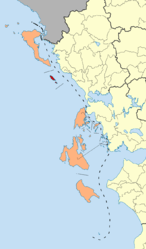 | |
| Coordinates: 39°12′N 20°10′E | |
| Country | Greece |
| Administrative region | Ionian Islands |
| Regional unit | Corfu |
| Area | |
| • Municipality | 30,121 km2 (11,630 sq mi) |
| Population (2011)[1] | |
| • Municipality | 2,300 |
| • Municipality density | 0.076/km2 (0.20/sq mi) |
| Time zone | UTC+2 (EET) |
| • Summer (DST) | UTC+3 (EEST) |
| Postal code | 490 82 |
| Area code(s) | 26620 |
| Vehicle registration | KY |
| Website | www.paxi.gr |
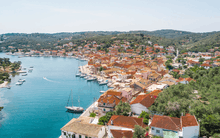
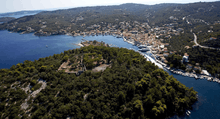
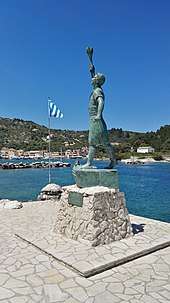
History
Although it was possibly inhabited from prehistoric times, the Phoenicians are traditionally held to have been the first settlers on Paxos. The name is believed to be derived from Pax, which meant trapezoidal in their language.[4]
This island is noted for the Battle of Paxos, fought between the ancient Greek and Illyrian fleets during the First Illyrian War in 229 BC. The battle is recorded by the ancient historian Polybius (The Histories, book 2, chapter 2).
The Romans ruled the island from the 2nd century BC, and during the Byzantine period and Middle Ages it was constantly attacked by pirates. After various rulers and Crusaders had passed through, the island was taken by the Venetians at the end of the 14th century.
During the Napoleonic wars, the Ionian Islands were taken by the French and the Russo-Turkish alliance. On 13 February 1814, the island of Paxos surrendered to the Royal Navy frigate HMS Apollo and 160 troops from the 2nd Greek Light Infantry from Cephalonia and the 35th Regiment of the Royal Corsican Rangers. In 1815, the United Kingdom established the Ionian Union. In 1864, together with the rest of the Heptanese, Paxos was ceded to Greece.
Geography
The island is approximately eight miles (13 km) in length and tipped up towards the west. The west coast is dominated by steep white, chalky cliffs that are greatly eroded at sea level, and harbour many 'blue caves', which can be explored on launches departing from Gaios. Much of the attractive landscape is still covered in olive groves. These stretch from Lakka, the harbour community in the north, through Magazia to Gaios, the capital. Olive oil making, soap manufacture and fishing were supplanted by tourism as the main industry in the mid sixties, resulting in a construction boom, which has greatly altered the coastline around Gaios, the capital of the Paxiot demos (community). There are ferry and jetfoil connections daily with Kerkyra (Corfu) and with the mainland at Igoumenitsa. Excursions via Corfu to Albania (the resort of Saranda and the magnificent Greco-Roman settlement of Butrint) can also be arranged with the local jetfoil operators.

Province
The province of Paxoi (Greek: Επαρχία Παξών) was one of the provinces of the Corfu Prefecture. Its territory corresponded with that of the current municipality Paxoi.[5] It was abolished in 2006.
Foreign residents
Among well known semi-permanent British inhabitants were Audrey Good, former commander of the UN refugee bases in Epirus following the Greek Civil War, the late actor Peter Bull (author of It Isn't All Greek to Me) and actress Susannah York. Some members of the Agnelli family (of FIAT fame) have built a palatial holiday home—complete with faux medieval tower—on a small island (Kaltonisi) situated near the southernmost tip ('the heel') of Paxos, close to the beach of Mongonissi. The presence of such residents, and the development of the coastal area (mostly by Italian nationals) explains why Paxos has now become one of the most expensive pieces of real estate in Greece. One of Loggos's landmarks, the so-called 'Manor House' was put on sale for 1.6M€ in 2006.
Paxos is part of a European network called Cultural Village of Europe. It hosts a yearly classical music festival (founded by John Gough, and now organised by the Guildhall), which attracts some of Europe's finest young performers. This festival usually takes place in late August/early September, however the 2010 festival is in doubt as sponsorship cannot be determined. Concerts are usually held in the now-disused school of Longos, Paxoi.
Transport
The island is serviced by ferry boats from the mainland Greece port of Igoumenitsa (1.5 hours), hydrofoils and ferry boats from Corfu (1-2 hours) and from Bari and Brindisi (4 hours). There is no airport but there was a privately owned seaplane service (7 minutes from Corfu town) operated by AirSea Lines. As of late 2009, this service is no-longer operational.
Dialect
A dialect is spoken resembling that of Corfu and having a similar prosody. It is heavily influenced by Italian. [6]
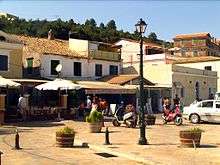
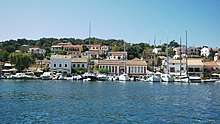
Trivia
In his scientific article The Part-Time Parliament, Leslie Lamport presented his Paxos algorithm for distributed voting, inventing a society on a fictional ancient Greek island named Paxos as a whimsical illustration of an otherwise dry subject. He later admitted that the allegory was a dismal failure, in that it failed to pique readers' interest in the underlying material.[7]
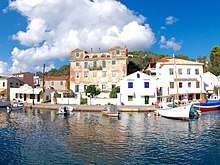
The Paxos Animal Welfare Society (PAWS) is a small Anglo-Greek charity, dating from 2005 and registered in the UK, whose purpose is to improve the plight of animals on this Greek island. The charity has established a permanent surgery at Magazia, which was opened by the mayor in September 2013.[8]
Communities and settlements
- Antipaxos (nearby island)
- Mogonisi (nearby island)
- Panagia (nearby island)
- Agios Nikolaos (nearby island)
- Katsonisi (nearby island)
- Apergatika
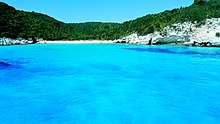 Paxi - Antipaxi coast
Paxi - Antipaxi coast - Argyratika
- Arvanitakeika
- AronatikaDalietatika
- Gaios (seat)
- Gramatikeika
- Lakka (second biggest settlement)
 Paxos west coast
Paxos west coast - Loggos (third biggest settlement)
- Magazia
- Makratika
- Ozias
- Platanos (or Fontana / Fountana) Velianitatika (or Veliantatika)
- Vlachopoulatika
- Zenebissatika
References
- "Απογραφή Πληθυσμού - Κατοικιών 2011. ΜΟΝΙΜΟΣ Πληθυσμός" (in Greek). Hellenic Statistical Authority.
- Kallikratis law Greece Ministry of Interior (in Greek)
- "Population & housing census 2001 (incl. area and average elevation)" (PDF) (in Greek). National Statistical Service of Greece.
- The official page of Paxos – History. 30 November 1999 http://www.paxi.gr/2008/index.php?lang=&page=2&article=2. Retrieved 13 November 2018. Missing or empty
|title=(help) - "Detailed census results 1991" (PDF). (39 MB) (in Greek and French)
- Glossary of Paxiot expressions
- The Writings of Leslie Lamport
- PAWS
External links
| Wikimedia Commons has media related to Paxi. |
| Wikisource has the text of the 1911 Encyclopædia Britannica article Paxo. |
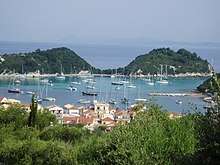

| Climate data for Loggos, Paxi (Λογγός, Παξοί) | |||||||||||||
|---|---|---|---|---|---|---|---|---|---|---|---|---|---|
| Month | Jan | Feb | Mar | Apr | May | Jun | Jul | Aug | Sep | Oct | Nov | Dec | Year |
| Average high °C (°F) | 13.9 (57.0) |
14.3 (57.7) |
16.0 (60.8) |
19.0 (66.2) |
23.9 (75.0) |
28.2 (82.8) |
31.1 (88.0) |
31.4 (88.5) |
27.6 (81.7) |
23.2 (73.8) |
18.5 (65.3) |
15.2 (59.4) |
21.9 (71.4) |
| Average low °C (°F) | 5.2 (41.4) |
5.8 (42.4) |
6.8 (44.2) |
9.5 (49.1) |
13.4 (56.1) |
16.9 (62.4) |
18.8 (65.8) |
19.3 (66.7) |
16.8 (62.2) |
13.8 (56.8) |
9.8 (49.6) |
6.7 (44.1) |
11.9 (53.4) |
| Average precipitation mm (inches) | 132 (5.2) |
136 (5.4) |
98 (3.9) |
62 (2.4) |
36 (1.4) |
14 (0.6) |
7 (0.3) |
18 (0.7) |
75 (3.0) |
148 (5.8) |
181 (7.1) |
180 (7.1) |
1,087 (42.9) |
| Source: Norwegian Meteorological Institute (temperatures)[1] and Holiday Weather.com (rainfall)[2] | |||||||||||||
